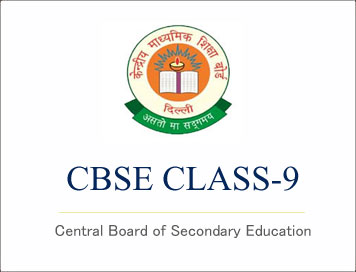CBSE Class-9 Syllabus 2018-19 (Art Education)
Disclaimer: This website is NOT associated with CBSE, for official website of CBSE visit - www.cbse.gov.in
CBSE Class-9 Syllabus 2018-19
(Art Education)
VISUAL ARTS
SYLLABUS
When the school(s) can provide art teachers in different media the following syllabus may be adopted. Activities in terms of Materials/Media and Techniques.
Two-dimensional or Pictorial Activities
• Study of visual resources and means of creative expression.
- Study of lines, strokes, colours, shades, tones, textures, etc. while organizing two dimensional space with two dimensional and three dimensional shapes and forms.
- Sketching from nature and surrounding.
- Creative use of colours to show space, atmosphere, subjective moods.
- Creative use of perspective in spatial relationship.
- Study of calligraphic strokes of Devnagari and Roman alphabet (Scripts).
- Use of contrast as an expressive element of art.
- Study and use of various media and techniques to the extent of their availability.
- Pencil, charcoal, water colour, crayon, oil colours, poster colour and gouache, acrylic colour and other unconventional sources of colours such as vermillion, yellow and red earth, rice flour, and tools like painting brushes for water colours and oil colours, Painting surfaces such as papers of various kinds and quality, like smooth, rough, thick, thin, etc., canvas, hardboard, simple marking cloth pasted on paper, etc.
- Collage and mosaic work with a variety of coloured papers and coloured printed pictures/photographs from magazines and newspapers.
- Printing : Mono printing, Printing with wood-cut blocks, lino-cut and metal foil : serigraphy (silk screen), self-made stencil, etc.
- Basic knowledge of computer graphics.
Three-dimensional or sculptural activities
• Study of basic forms in clay
- Study of various materials such as clay, plaster of paris, soft-stone, wood (blocks, twigs and branches, roots, etc.), metal scraps, plastic sheets, wire thread, papers and cardboards, vegetables and other throw-away available materials.
- Study of natural and man-made forms, human figures, birds, animals, vegetation and other objects like household items, buildings or as desired by the students.
- Objects of day-to-day use in groups and in different settings and arrangements. Assignments Assignments in two and three-dimensional subjective forms and utility and functional
art and craft forms in different media and techniques. Painting, murals, graphics, clay modelling, wood-carving, soft-stone, plaster of paris, block of brick constructions, collage mobils, applique, pottery and ceramics, masks, and puppets, textile designing (including tie-dye and batik, and block printing) poster designing, lay-out illustrations and photography, etc.
Correlating Art Activities with Other School Activities
• Construction of puppets and their costumes and improvised puppet stage or theatre, correlation with Home Science and Arts (Drama) subjects.
• Aesthetic organization of the physical environment by enhancing the surrounding area, i.e., landscaping including plantation of trees and other flowering plants and vegetables, etc., correlating with Agriculture, Home Science and Environment Studies activities.
• Constructing stage setting props such as curtain, backdrops, stage lighting, improvised furniture sets, etc., designing utility (crafts) items; correlating with Work Education activities.
• Designing the school magazine and bulletin boards, making posters for school functions, and greeting/invitation cards, stage scenes for music, dance, drama performances, etc., correlating with applied Art activities.
Note: These activities and other group activities may emerge in project form at individual levels also.
Group Activities
• Organization, display and exhibitions of students’ periodical and sessional work.
• Organizing inter school art exhibitions to widen their interaction and horizon.
• Planning and organizing festivals and celebrations of the community, cultural evenings, musical concerts, film shows and other performances including regional and folk (traditional art forms).
• Participating in study visits to museums, botanical gardens, zoological garden, art galleries and art institutions, etc., for greater awareness of the environment and cultural variations.
Theoretical Understanding of Art and Culture
• Short notes on important aspects of Indian art and culture based on Social Science. Such writing may be based on reproduction of art work printed in Textbooks.
• Contribution made by any one contemporary artist.
• Knowledge of terms : Contour, texture, graphic, form, volume, space, tone, printmaking, collage, amateur, modelling in relief, mobil construction, applique, calligraphy, layout, poster and composition.
B. Performing Arts
Music (Vocal)
• Theory
- Knowledge of the terms: Sangeet, Nad, Swar, Shudh, Komal, Teevra, Saptak, Mandra, Madhya Tar, Aroha Avaroha, Raga, Laya, Matra, Tal, Avartan, Sam Tal.
- Basics knowledge of notation systems.
- A brief introduction of Indian music
• Practical Activities
- National Anthem
- Songs for community singing
a) Five folk or tribal songs of different regions, indicating time of the year, occasion and the function with which they related. Writing down the same with its meaning and knowledge of its rhythm.
b) Five devotional songs (Bhajans, Shlokas, Hymns, Sufiana Kalam and Shabad Kirtan)
c) Three songs in regional languages other than mother tongue.
d) Three patriotic songs on the theme of universal love and amity.
To create proper sense of swara and laya through Talabadh and Alankaras. Introduction to the structure of any four of the following Ragas with : Bilawal, Yaman, Kafi, Bhairav, Shankarabharan, Kalyani, Mayamalav gaud, Todi (accompaniment of Tanpura and Tabla or Mrudang). The Teacher should communicate the characteristic features of the raga and its swaras pattern. The teacher may use references of popular songs for Raga association. The following tals and their thekas-Kaharva, Dadra, Trital, Jhaptal & Aditala, Alankar
Talas.
Click Here To Download Full Syllabus
Courtesy: CBSE
